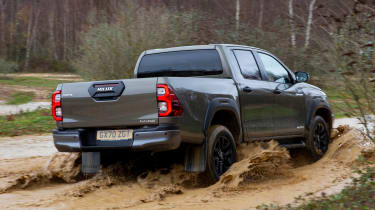Toyota Hilux pickup - Engines, drive & performance
As long as you’re not expecting too much of a car-like experience, the Toyota Hilux is easy and enjoyable to drive
If you’re not familiar with today’s pickups and are expecting something a little agricultural, then you might be surprised to learn that just as modern 4x4s are no longer the wallowy, unrefined vehicles they once were, pickups are now much more car-like – without losing the qualities that allow them to operate reliably in tough working conditions. The Toyota Hilux is no exception. You sit upright and high up, so the view out over most other traffic is excellent, while the accurate steering instils confidence, which is welcome given the Hilux’s size. It’s also impressively comfortable over bumps and drain covers. A proper SUV would be smoother but the Hilux is a reasonably appealing prospect for long journeys and does a great job of insulating you from potholes and other road imperfections.
You won’t be seeking out a winding B-road, though – there’s too much body lean and not enough grip when cornering for the Toyota to be genuinely enjoyable – but, overall, it’s competent and reassuring to drive. We did find the back end jiggled about a little when the load bay was empty, though. This is a result of the suspension being set up to support a serious amount of weight and is a common characteristic of most pickup trucks.
More reviews
In-depth reviews
The Hilux should be capable when off-roading too. Toyota lists an approach angle of 29 degrees, a departure angle of up to 26 degrees, the ability to climb a 42-degree slope, and a wading depth of up to 700mm. While those stats don’t quite match a serious off-roader like the Land Rover Defender, they should more than handle the obstacles of a muddy work site or farm track.
Toyota Hilux diesel engine
The entry-level 2.4-litre diesel engine has 148bhp. That may not sound like much, but it actually has plenty of pulling power – enough to haul a 3,500kg load using the tow bar or carry up to 1,030kg in the load bed. The equivalent Nissan Navara has more power and is a little faster, but the Hilux will be swift enough for most. Acceleration from 0-62mph takes 13.2 seconds with the manual gearbox and 12.7 seconds with the automatic. As mentioned earlier, we’d recommend saving around £1,500 by choosing the manual – it’s smooth and makes the Hilux more economical, too. The top speed for both is 105mph.
As part of the late 2020 facelift, the 2.8-litre diesel engine was introduced to the Hilux lineup for the first time. It produces 201bhp, and provides a decent performance boost over the smaller engine, taking 10.1 seconds from 0-62mph with a manual gearbox and 10.7 seconds when equipped with an automatic. Top speed rises only a touch, to 108mph.
On the road, the extra power of the larger 2.8-litre diesel engine is noticeable, with the added pulling power making for more relaxed acceleration. It still emits a decent amount of diesel clatter under acceleration if you rev it hard, but the extra power makes it far easier to get up to speed. This makes the plusher versions of the Hilux more refined and comfortable at motorway speeds, with only a small amount of tyre roar and wind noise in the background.
While the facelifted Hilux is impressive on road, its off-road ability is equally good. It’s well prepared for off-road use, with hill descent control, a tweaked stability control system, improved throttle response, a lower engine speed and an easy-to-use low-range 4WD mode. Our test car was running on standard road tyres, which were sufficient to show the Hilux has more than enough mud-plugging ability for most owners. The car’s capable assistance systems help it traverse the rough stuff with relative ease.










